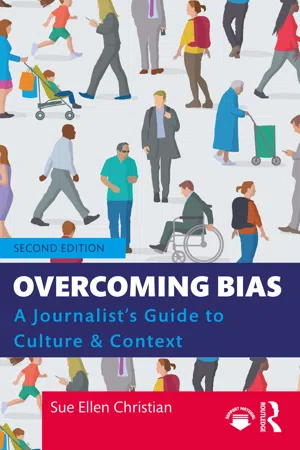
- 300 pages
- English
- ePUB (mobile friendly)
- Available on iOS & Android
About This Book
In this practical and engaging new edition, experienced reporter and teacher Sue Ellen Christian offers a fully updated and fresh take on reporting without bias, examining the way that we categorize people, filter information and default to rehearsed ways of thinking.
This book is about biases that affect journalism at every stage of reporting and writing. Included throughout are stories and advice from working reporters and editors, providing real-world voices and experiences, and covering questions of culture, stereotyping, sources, writing, editing, visuals and reflective practice. This advice and guidance is coupled with practical exercises that give readers the chance to apply what they learn. Christian provides a career-long foundation for those looking to edit their thinking and to champion a more inclusive and open-minded approach to coverage of our multicultural society.
Offering a concise, readable and highly applicable guide to managing coverage of contemporary social issues, this book is an ideal resource for undergraduate and graduate students of journalism and early career journalists.
Frequently asked questions
Information
1 Context, Culture and Cognition
Making the Case for Reflective Practice in Journalism
- To understand the elements and value of effective multicultural reporting.
- To recognize that journalists’ own cultures and backgrounds may affect how they interpret and understand news events and news sources.
- To differentiate between correlation and causation for more accurate reporting.
- To know the journalistic principles that support inclusive journalism.
Confronting Our Blind Spots
That audio recording was helpful to me. It wasn’t just, ‘This is what happened and this is what happened’ … it was in talking about it that at one point I realized what bothered me about it – it was the fact that he felt comfortable saying that to me. I didn’t realize it at the time, but I did when I thought about it later.
I got into town just after sunset. The lights were on at a place called the Brick House Grill, and if you were out on South Main Street on a Friday night in February, chances are, that’s where you were going. So I went in, too.
I took a seat at the bar. A man two stools over from me struck up a conversation. I told him I was a journalist from Chicago and asked him to tell me about this town. “You know how this town is called Anna?” he started. “That’s for ‘Ain’t No N------2 Allowed.’” He laughed, shook his head and took a sip of his beer.
The man was white. I am white. Everyone else in that restaurant in Anna was white.
Later that night, I realized what shook me most about our conversation: He didn’t pause before he said what he said. He didn’t look around the room to see whether anyone could hear us. He didn’t lower his voice. He just said it.3
I asked myself it a lot: Could have I done this story if I wasn’t white? For a lot of reasons it wouldn’t have been the same story. Me being a white person I think made people feel like I was … somehow complicit in the same feelings and attitudes.
“I think a lot about the idea of fact checking: Fact checking is checking facts. But how do you fact check the underlying narrative of a place, a community? How do you know the reason why you are reporting in a place or why you went to a particular neighborhood is the narrative that is held by everybody? That is an endlessly fascinating question to me,” she says.
Journalism with an Open Mind
- What preconceptions do you bring to different situations?
- What do you notice?
- What don’t you notice?
- How do you categorize people and events?
- How does your upbringing affect your ability to interact with people unlike you?
- Is your mind able to tolerate some ambiguity in a situation?
- Do you need things to be concrete and quickly defined?
Table of contents
- Cover
- Half Title
- Title Page
- Copyright Page
- Dedication
- Table of Contents
- Preface
- Acknowledgments
- 1 Context, Culture and Cognition: Making the Case for Reflective Practice in Journalism
- 2 Habits of Thought: How Cognitive Processes Influence Journalistic Practice
- 3 Encountering the News: How the Mind Organizes and Interprets Information – and How Story Ideas Get Lost in the Process
- 4 Story without Stereotype: How Stereotypes May Influence Reporting in Stealthy Ways – and What to Do about It
- 5 Understanding Culture, Understanding Sources: How Social Groups Serve as Lenses for Looking at the World
- 6 Training the Reporter’s Eye :What Attracts Journalists’ Attention Can Influence How They Portray Events and Explain Behaviors
- 7 Critical Decisions before Deadline: Why Even Experienced Journalists Neglect Certain Facts and What to Do About It
- 8 The Power of Words and Tone: When Words Suggest Unintended Meanings
- 9 Attribution, Images and Editing without Bias: When to Include Data, What Images Communicate and How to Determine Cause
- 10 Addressing Negativity: How to Manage Hate Speech, Hostile Sources and Misinformation
- 11 Journalism and Reflective Practice: Cultivating an Open Mind
- Index